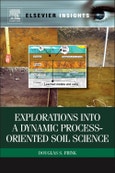The paradigm and models of traditional soil science lack the ability to adequately address issues of soil dynamics, environmental integration, and change. Unexplainable research results obtained from traditional soil studies applied to non-traditional soil phenomena in physical geography, archaeology and ecology speak to the current need for soil science to move beyond description and classification and into a dynamic process-oriented soil science capable of providing explanations. Soils do not behave as static inert geologic detritus affected by climate, organisms, relief, and parent material through time, but instead soils behave as self-organizing systems dynamically interrelating with their environment. Recognition of this dynamic behaviour required a re-examination of how scientists in general think and in how modern soil science specifically evolved its basic paradigms and models.
This book examines the dynamics of soil organic carbon and demonstrates the self-organizing nature of soil through time as soil responds to a wide range of environmental and human perturbations.
Please Note: This is an On Demand product, delivery may take up to 11 working days after payment has been received.
Table of Contents
1: Introduction to a Dynamic Process-Oriented Soil Science
2: Soil Science in Historical and Philosophical Perspective
3: Self-Organization as a Result of Perturbations in a Dynamic Process-Oriented Soil Science
4: Soil Physiology: Processes of a Dynamic
5: The OCR Procedure as Applied Dynamic Process-Oriented Soil Science: The Initial Iterations of the OCR Formula
6: Applications of OCR Dating
7: Implications and Potentials of a Process-Oriented Soil Science
8.Summary







